Lizhen Cui
Relational Database Distillation: From Structured Tables to Condensed Graph Data
Oct 08, 2025Abstract:Relational databases (RDBs) underpin the majority of global data management systems, where information is structured into multiple interdependent tables. To effectively use the knowledge within RDBs for predictive tasks, recent advances leverage graph representation learning to capture complex inter-table relations as multi-hop dependencies. Despite achieving state-of-the-art performance, these methods remain hindered by the prohibitive storage overhead and excessive training time, due to the massive scale of the database and the computational burden of intensive message passing across interconnected tables. To alleviate these concerns, we propose and study the problem of Relational Database Distillation (RDD). Specifically, we aim to distill large-scale RDBs into compact heterogeneous graphs while retaining the predictive power (i.e., utility) required for training graph-based models. Multi-modal column information is preserved through node features, and primary-foreign key relations are encoded via heterogeneous edges, thereby maintaining both data fidelity and relational structure. To ensure adaptability across diverse downstream tasks without engaging the traditional, inefficient bi-level distillation framework, we further design a kernel ridge regression-guided objective with pseudo-labels, which produces quality features for the distilled graph. Extensive experiments on multiple real-world RDBs demonstrate that our solution substantially reduces the data size while maintaining competitive performance on classification and regression tasks, creating an effective pathway for scalable learning with RDBs.
Information Bottleneck-based Causal Attention for Multi-label Medical Image Recognition
Aug 11, 2025Abstract:Multi-label classification (MLC) of medical images aims to identify multiple diseases and holds significant clinical potential. A critical step is to learn class-specific features for accurate diagnosis and improved interpretability effectively. However, current works focus primarily on causal attention to learn class-specific features, yet they struggle to interpret the true cause due to the inadvertent attention to class-irrelevant features. To address this challenge, we propose a new structural causal model (SCM) that treats class-specific attention as a mixture of causal, spurious, and noisy factors, and a novel Information Bottleneck-based Causal Attention (IBCA) that is capable of learning the discriminative class-specific attention for MLC of medical images. Specifically, we propose learning Gaussian mixture multi-label spatial attention to filter out class-irrelevant information and capture each class-specific attention pattern. Then a contrastive enhancement-based causal intervention is proposed to gradually mitigate the spurious attention and reduce noise information by aligning multi-head attention with the Gaussian mixture multi-label spatial. Quantitative and ablation results on Endo and MuReD show that IBCA outperforms all methods. Compared to the second-best results for each metric, IBCA achieves improvements of 6.35\% in CR, 7.72\% in OR, and 5.02\% in mAP for MuReD, 1.47\% in CR, and 1.65\% in CF1, and 1.42\% in mAP for Endo.
DAG-AFL:Directed Acyclic Graph-based Asynchronous Federated Learning
Jul 28, 2025Abstract:Due to the distributed nature of federated learning (FL), the vulnerability of the global model and the need for coordination among many client devices pose significant challenges. As a promising decentralized, scalable and secure solution, blockchain-based FL methods have attracted widespread attention in recent years. However, traditional consensus mechanisms designed for Proof of Work (PoW) similar to blockchain incur substantial resource consumption and compromise the efficiency of FL, particularly when participating devices are wireless and resource-limited. To address asynchronous client participation and data heterogeneity in FL, while limiting the additional resource overhead introduced by blockchain, we propose the Directed Acyclic Graph-based Asynchronous Federated Learning (DAG-AFL) framework. We develop a tip selection algorithm that considers temporal freshness, node reachability and model accuracy, with a DAG-based trusted verification strategy. Extensive experiments on 3 benchmarking datasets against eight state-of-the-art approaches demonstrate that DAG-AFL significantly improves training efficiency and model accuracy by 22.7% and 6.5% on average, respectively.
Benchmarking Multimodal Knowledge Conflict for Large Multimodal Models
May 26, 2025Abstract:Large Multimodal Models(LMMs) face notable challenges when encountering multimodal knowledge conflicts, particularly under retrieval-augmented generation(RAG) frameworks where the contextual information from external sources may contradict the model's internal parametric knowledge, leading to unreliable outputs. However, existing benchmarks fail to reflect such realistic conflict scenarios. Most focus solely on intra-memory conflicts, while context-memory and inter-context conflicts remain largely investigated. Furthermore, commonly used factual knowledge-based evaluations are often overlooked, and existing datasets lack a thorough investigation into conflict detection capabilities. To bridge this gap, we propose MMKC-Bench, a benchmark designed to evaluate factual knowledge conflicts in both context-memory and inter-context scenarios. MMKC-Bench encompasses three types of multimodal knowledge conflicts and includes 1,573 knowledge instances and 3,381 images across 23 broad types, collected through automated pipelines with human verification. We evaluate three representative series of LMMs on both model behavior analysis and conflict detection tasks. Our findings show that while current LMMs are capable of recognizing knowledge conflicts, they tend to favor internal parametric knowledge over external evidence. We hope MMKC-Bench will foster further research in multimodal knowledge conflict and enhance the development of multimodal RAG systems. The source code is available at https://github.com/MLLMKCBENCH/MLLMKC.
Efficient Shapley Value-based Non-Uniform Pruning of Large Language Models
May 03, 2025Abstract:Pruning large language models (LLMs) is a promising solution for reducing model sizes and computational complexity while preserving performance. Traditional layer-wise pruning methods often adopt a uniform sparsity approach across all layers, which leads to suboptimal performance due to the varying significance of individual transformer layers within the model not being accounted for. To this end, we propose the \underline{S}hapley \underline{V}alue-based \underline{N}on-\underline{U}niform \underline{P}runing (\methodname{}) method for LLMs. This approach quantifies the contribution of each transformer layer to the overall model performance, enabling the assignment of tailored pruning budgets to different layers to retain critical parameters. To further improve efficiency, we design the Sliding Window-based Shapley Value approximation method. It substantially reduces computational overhead compared to exact SV calculation methods. Extensive experiments on various LLMs including LLaMA-v1, LLaMA-v2 and OPT demonstrate the effectiveness of the proposed approach. The results reveal that non-uniform pruning significantly enhances the performance of pruned models. Notably, \methodname{} achieves a reduction in perplexity (PPL) of 18.01\% and 19.55\% on LLaMA-7B and LLaMA-13B, respectively, compared to SparseGPT at 70\% sparsity.
Diversity-aware Dual-promotion Poisoning Attack on Sequential Recommendation
Apr 09, 2025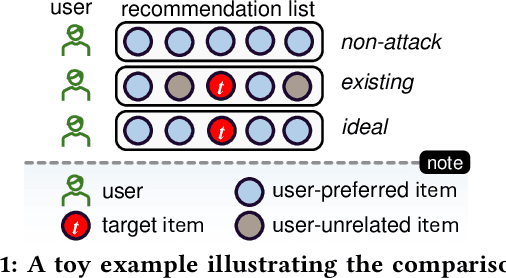

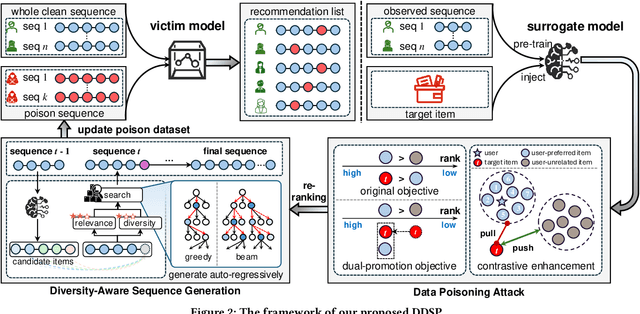
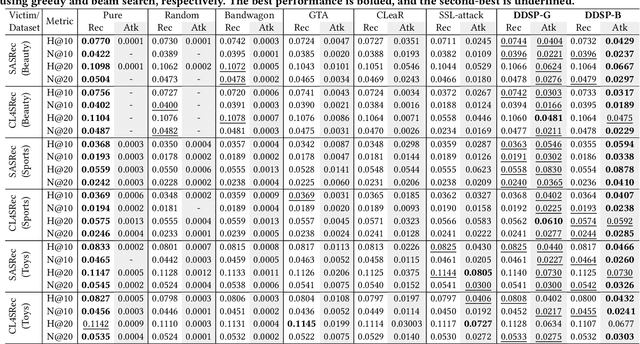
Abstract:Sequential recommender systems (SRSs) excel in capturing users' dynamic interests, thus playing a key role in various industrial applications. The popularity of SRSs has also driven emerging research on their security aspects, where data poisoning attack for targeted item promotion is a typical example. Existing attack mechanisms primarily focus on increasing the ranks of target items in the recommendation list by injecting carefully crafted interactions (i.e., poisoning sequences), which comes at the cost of demoting users' real preferences. Consequently, noticeable recommendation accuracy drops are observed, restricting the stealthiness of the attack. Additionally, the generated poisoning sequences are prone to substantial repetition of target items, which is a result of the unitary objective of boosting their overall exposure and lack of effective diversity regularizations. Such homogeneity not only compromises the authenticity of these sequences, but also limits the attack effectiveness, as it ignores the opportunity to establish sequential dependencies between the target and many more items in the SRS. To address the issues outlined, we propose a Diversity-aware Dual-promotion Sequential Poisoning attack method named DDSP for SRSs. Specifically, by theoretically revealing the conflict between recommendation and existing attack objectives, we design a revamped attack objective that promotes the target item while maintaining the relevance of preferred items in a user's ranking list. We further develop a diversity-aware, auto-regressive poisoning sequence generator, where a re-ranking method is in place to sequentially pick the optimal items by integrating diversity constraints.
LexPro-1.0 Technical Report
Mar 11, 2025Abstract:In this report, we introduce our first-generation reasoning model, LexPro-1.0, a large language model designed for the highly specialized Chinese legal domain, offering comprehensive capabilities to meet diverse realistic needs. Existing legal LLMs face two primary challenges. Firstly, their design and evaluation are predominantly driven by computer science perspectives, leading to insufficient incorporation of legal expertise and logic, which is crucial for high-precision legal applications, such as handling complex prosecutorial tasks. Secondly, these models often underperform due to a lack of comprehensive training data from the legal domain, limiting their ability to effectively address real-world legal scenarios. To address this, we first compile millions of legal documents covering over 20 types of crimes from 31 provinces in China for model training. From the extensive dataset, we further select high-quality for supervised fine-tuning, ensuring enhanced relevance and precision. The model further undergoes large-scale reinforcement learning without additional supervision, emphasizing the enhancement of its reasoning capabilities and explainability. To validate its effectiveness in complex legal applications, we also conduct human evaluations with legal experts. We develop fine-tuned models based on DeepSeek-R1-Distilled versions, available in three dense configurations: 14B, 32B, and 70B.
COSINT-Agent: A Knowledge-Driven Multimodal Agent for Chinese Open Source Intelligence
Mar 05, 2025



Abstract:Open Source Intelligence (OSINT) requires the integration and reasoning of diverse multimodal data, presenting significant challenges in deriving actionable insights. Traditional approaches, including multimodal large language models (MLLMs), often struggle to infer complex contextual relationships or deliver comprehensive intelligence from unstructured data sources. In this paper, we introduce COSINT-Agent, a knowledge-driven multimodal agent tailored to address the challenges of OSINT in the Chinese domain. COSINT-Agent seamlessly integrates the perceptual capabilities of fine-tuned MLLMs with the structured reasoning power of the Entity-Event-Scene Knowledge Graph (EES-KG). Central to COSINT-Agent is the innovative EES-Match framework, which bridges COSINT-MLLM and EES-KG, enabling systematic extraction, reasoning, and contextualization of multimodal insights. This integration facilitates precise entity recognition, event interpretation, and context retrieval, effectively transforming raw multimodal data into actionable intelligence. Extensive experiments validate the superior performance of COSINT-Agent across core OSINT tasks, including entity recognition, EES generation, and context matching. These results underscore its potential as a robust and scalable solution for advancing automated multimodal reasoning and enhancing the effectiveness of OSINT methodologies.
CodeV: Issue Resolving with Visual Data
Dec 23, 2024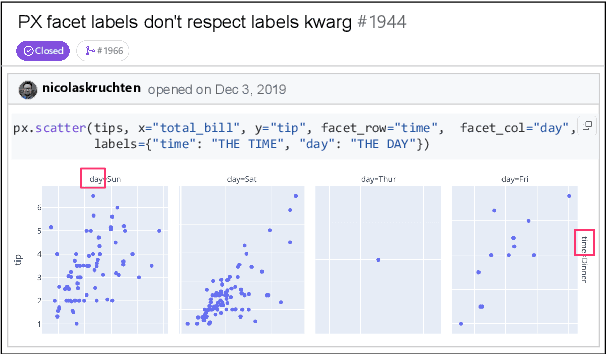
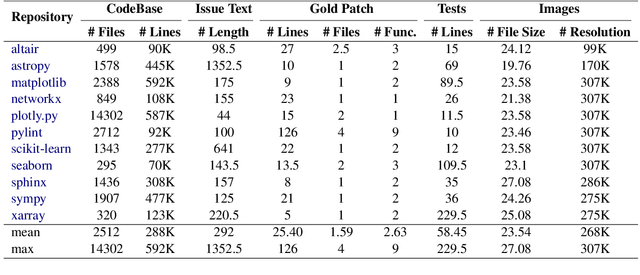
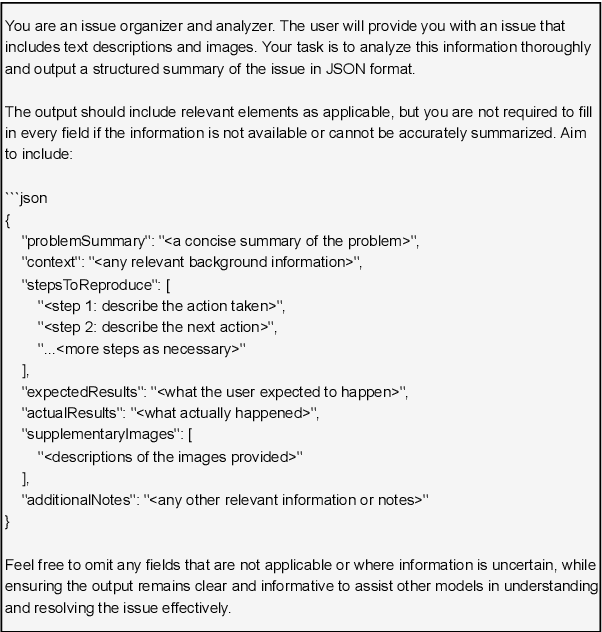
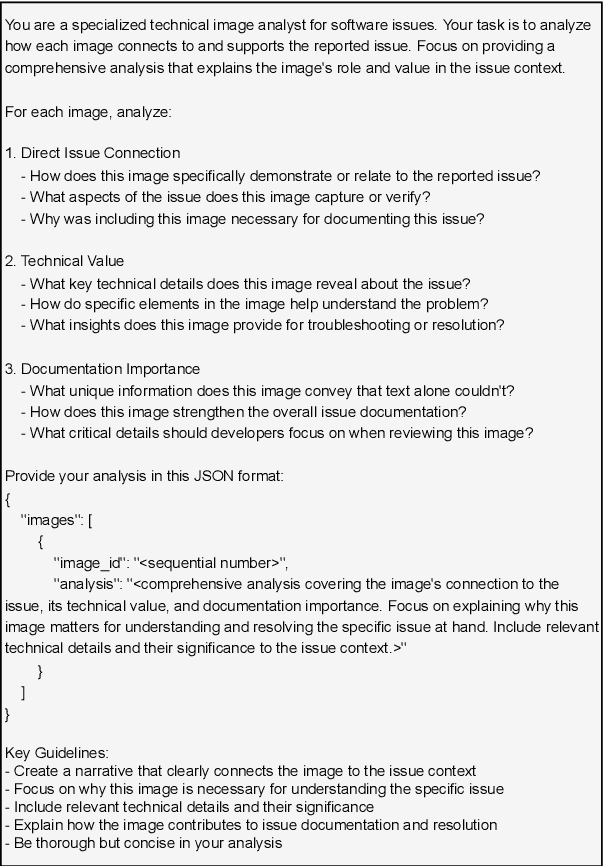
Abstract:Large Language Models (LLMs) have advanced rapidly in recent years, with their applications in software engineering expanding to more complex repository-level tasks. GitHub issue resolving is a key challenge among these tasks. While recent approaches have made progress on this task, they focus on textual data within issues, neglecting visual data. However, this visual data is crucial for resolving issues as it conveys additional knowledge that text alone cannot. We propose CodeV, the first approach to leveraging visual data to enhance the issue-resolving capabilities of LLMs. CodeV resolves each issue by following a two-phase process: data processing and patch generation. To evaluate CodeV, we construct a benchmark for visual issue resolving, namely Visual SWE-bench. Through extensive experiments, we demonstrate the effectiveness of CodeV, as well as provide valuable insights into leveraging visual data to resolve GitHub issues.
Memory-enhanced Invariant Prompt Learning for Urban Flow Prediction under Distribution Shifts
Dec 07, 2024



Abstract:Urban flow prediction is a classic spatial-temporal forecasting task that estimates the amount of future traffic flow for a given location. Though models represented by Spatial-Temporal Graph Neural Networks (STGNNs) have established themselves as capable predictors, they tend to suffer from distribution shifts that are common with the urban flow data due to the dynamics and unpredictability of spatial-temporal events. Unfortunately, in spatial-temporal applications, the dynamic environments can hardly be quantified via a fixed number of parameters, whereas learning time- and location-specific environments can quickly become computationally prohibitive. In this paper, we propose a novel framework named Memory-enhanced Invariant Prompt learning (MIP) for urban flow prediction under constant distribution shifts. Specifically, MIP is equipped with a learnable memory bank that is trained to memorize the causal features within the spatial-temporal graph. By querying a trainable memory bank that stores the causal features, we adaptively extract invariant and variant prompts (i.e., patterns) for a given location at every time step. Then, instead of intervening the raw data based on simulated environments, we directly perform intervention on variant prompts across space and time. With the intervened variant prompts in place, we use invariant learning to minimize the variance of predictions, so as to ensure that the predictions are only made with invariant features. With extensive comparative experiments on two public urban flow datasets, we thoroughly demonstrate the robustness of MIP against OOD data.
 Add to Chrome
Add to Chrome Add to Firefox
Add to Firefox Add to Edge
Add to Edge